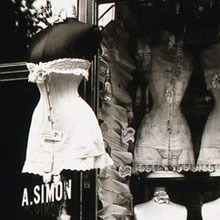Through the Looking Glass: Doorways, Windows, and Mirrors in Photography

Eugène Atget (French, 1857-1927), Boulevard de Strasbourg, Corsets, 1912 (negative); printed later, gelatin silver print, Museum Purchase: Funds provided by Mrs. Alda Jourdan and Mr. Robert Paulus, no known copyright restrictions, 53.10.3
2011
Like the viewfinder of a camera, windows, doorways, and mirrors shape our views of the world around us. As frames appearing within photographs, they can add to an image's spatial cohesion and composition, and often serve to suggest mood and psychological depth. The current gallery rotation from the Museum’s permanent collection features more than sixty photographs that highlight the significant and intricate role that windows, doorways, and mirrors have played throughout photography's 185-year history.
In about 1826 French gentleman-scientist Joseph Nicéphore Niépce created what is considered to be the world's first photograph. The one-of-a-kind polished pewter plate, now in the collection of the Harry Ransom Center, University of Texas at Austin, is titled View from the Window at Le Gras and features an outdoor scene composed through a rear window on the upper floor of Niépce's home. Other early photography practitioners such as Louis-Jacques-Mandé Daguerre and William Henry Fox Talbot frequently integrated windows and doorways into their images, and these compositional effects have remained prevalent and meaningful even into the digital age.
On the surface, windows and doorways are architectural apertures that permit or restrict the movement of individuals, objects, and even atmosphere; they also allow or deny views into or out of private spaces. More than mere structural boundaries, however, they can be interpreted as psychological membranes embodying the rich tension between acceptance and rejection. Similarly, the mirror has long been used in literature and art to represent concepts such as self-awareness, narcissism, mortality, and alternate realities.
As the works on view make clear, windows, mirrors, and doorways in photographs function at times as purely visual devices and at others as metaphors for substantial concepts. Whether transparent or opaque, they serve as gateways to guide viewers toward new and ever-changing territory, in both our interior and exterior worlds.
Curated by Julia Dolan
- Exhibition Title
Through the Looking Glass: Doorways, Windows, and Mirrors in Photography
- Date
2011
- Curated by
Julia Dolan
- Begin Date
2011-10-29
- End Date
2012-05-06






